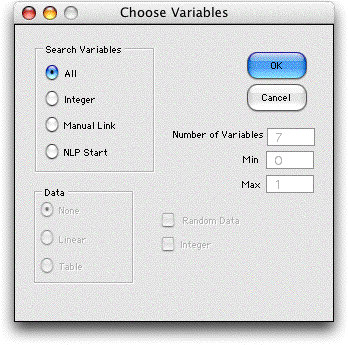|
To treat the math
programming model as a combinatorial problem choose Math
Program from the Optimize menu. The dialog below
is presented.

The buttons in the Search Variables region
of the dialog select the variables to be used for the combinatorial
optimization. For this example we choose the All button.
This means that all the model variables will be varied in the
search for the optimum. We illustrate the other choices later.
The worksheet is modified in several ways by the add-in. The
cells that represent the model variables, Values and
the Lower and Upper Bounds, receive new names
so that they also become the combinatorial variables and their
limits. Thus the range H8:N8 holds both the math programming
variables and the combinatorial variables, so it is unnecessary
to manually link them. Similarly, cell F4 is assigned a new
name so it represents both the model objective function and
the combinatorial objective function, again removing the requirement
to manually link the two cells.
Formulas are added to the right of the model (column O for
this case) that compute the values of the slack variables for
the constraints. In the next column (P) formulas are included
that evaluate as positive quantities for violated constraints
and 0 for satisfied constraints. A value in column P shows the
amount by which a constraint is violated. Since the current
solution is feasible (all 0's) and all the constraints are satisfied,
column P holds all 0's. The figure below shows the added columns.
|



